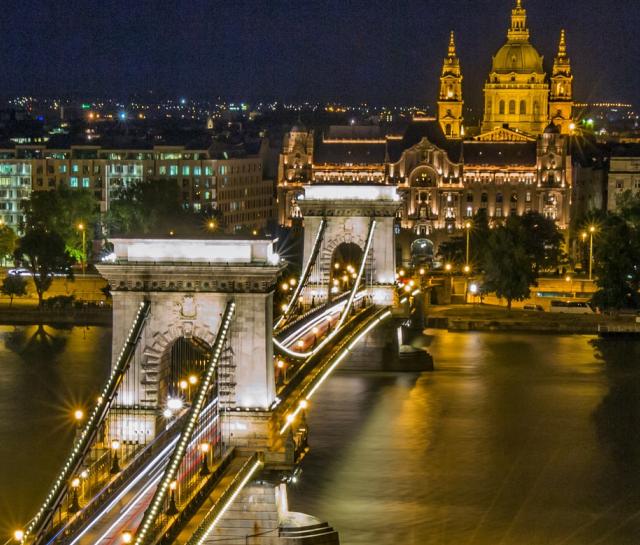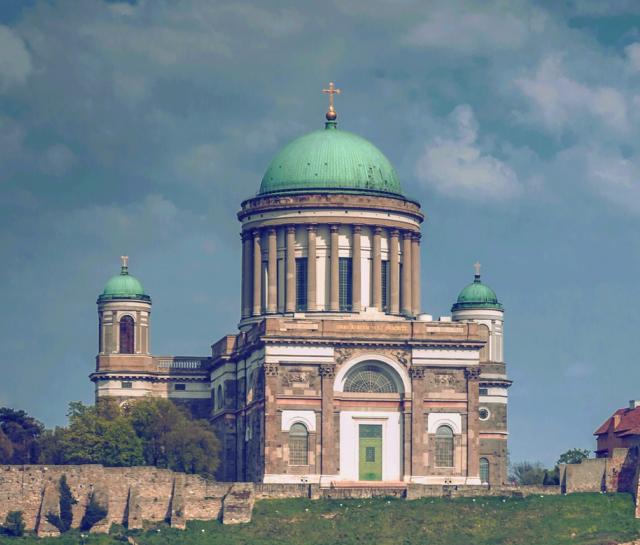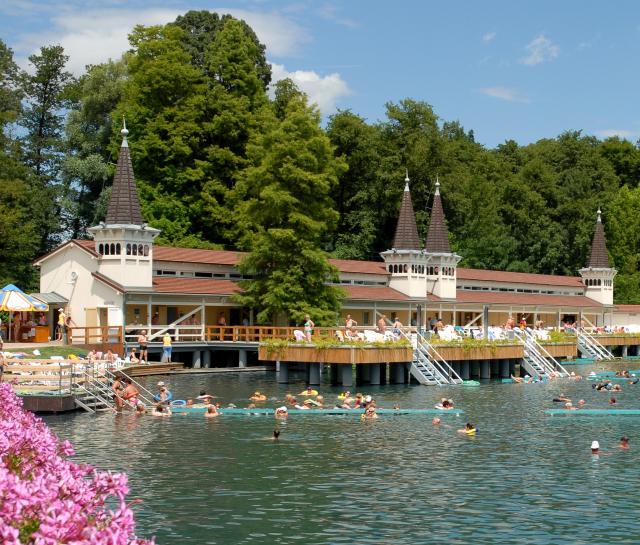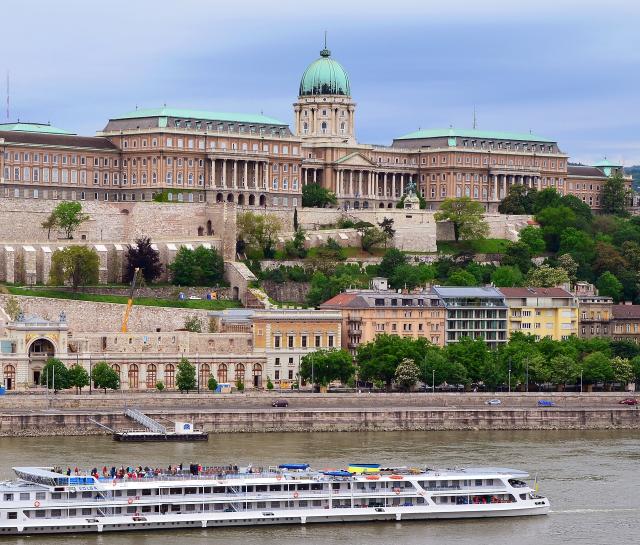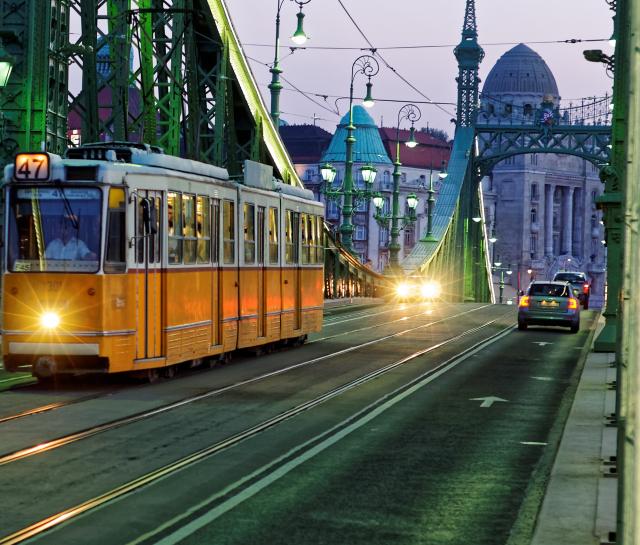Budapest and surroundings
Buda
Some fall in love with the city at first sight, others are won over only after a longer period of discovery; but all agree that it is one of the most beautiful locations in the world. The metropolis with a population of two million is bisected by the mighty flow of the Danube with hills and valleys on the Buda side and the flat, low-lying Pest on the other. The riverside panorama has been declared a World Heritage site by UNESCO. Anybody who has ever seen it illuminated by night can understand why.
The most important sites of the city can be found in Buda, on the right bank of the Danube. Buda is the capital city's green belt with popular hiking destinations, all of them parts of the Buda Nature Reserve.
The Castle District was Erected in the 14th century and rebuilt in the Baroque style 400 years later. Today it houses Budapest's most frequented museums and galleries. The Hungarian National Gallery offers a selection of the history of arts in Hungary from the 10th century to the present day.
Not many cities have a hill rising from the city centre and protected as a national park. Gellért Hill has a fortress called the Citadel on top of it, which was built in 1851, and is now a tourist attraction with terraces offering the fullest panoramic view of the city. The hot springs deep inside the hill supply three spas at the foot of the hill. The Gellért Thermal Baths, Hungary's grandest spa.
Pest
Pest, on the left bank of the Danube, also has many historic districts, resorts and famous sights. There are nine bridges spanning the Danube, the oldest being the Széchenyi Chain Bridge built in 1849.
At 2 Dohány utca Europe's largest synagogue is found, serving also as a concert hall of excellent acoustics. The Hungarian National Museum (14-16 Múzeum körút) is the finest example of Hungarian Classicist architecture. The Vásárcsarnok ('Grand Market Hall', 1-3 Fővám körút) is striking in its architectural inventiveness.
The Parliament (Kossuth Lajos tér) is the largest and the most lavishly decorated building in the country. Built between 1885 and 1902 by Imre Steindl, this exquisite edifice is 96-m high and 118-m wide. It is accessible only by guided tours in groups.
The neo-Renaissance St. Stephen's Basilica (Bajcsy-Zsilinszky út), elevated to the rank of basilica minor, is the largest church in Budapest, and the second largest in Hungary. The tower balcony of the basilica offers a splendid uninterrupted panorama of the whole of the city.
It is worth taking a walk along the straight Andrássy út, a boulevard that is now a World Heritage site. It is lined with 19th- and 20th-century Eclectic-style palaces. The State Opera House (22 Andrássy út), with its frescoed interior, seating an audience of 1,200, is a splendid work of by Miklós Ybl, Hungary's most famous architect, and has been the centre of musical life in Hungary since 1864.
The Margaret Island Lying in the centre of Budapest and the River Danube and can easily be accessed on foot from both banks of the river or by bus. A broad 2-km long green expanse of land stretching between Margaret Bridge and Árpád Bridge, the island is Budapest's most treasured and beloved park.
(Szentendre, Visegrád, Esztergom, Vác, Gödöllő)
Szentendre, with its winding lanes, seven aspiring church towers, colorful houses, narrow side streets, genuine Mediterranean ambience and scores of museums, galleries, guest houses and warm restaurants, is the most frequented tourist destination of the Danube Bend.
In Visegrád you can visit the breathtaking palace of the great Renaissance monarch, King Matthias (1458-1490). With 350 rooms and two-tier fountains of red marble, it was one of the most luxurious royal residences of the age.
Esztergom is the seat of the archbishop of Esztergom, the primate of the Hungarian Catholic Church. The cathedral incorporates the early 16th-century red marble Bakócz Chapel, the only intact Renaissance edifice in Hungary. The Treasury of the Cathedral exhibits the richest collection of Hungarian ecclesiastical art of some 400 items.
Vác is a one-thousand-year-old Episcopal seat on the Danube bank. It was the terminus of the first railway service launched in Pest in 1846, at the time trains arrived here at a speed of 30 km per hour. The country's only triumphal arch, the Kőkapu ('Stone Gate'), can be seen here, erected in 1764 to celebrate the visit of the Empress Maria Theresa.
Emperor Franz Joseph and his royal consort Queen Elisabeth, affectionately called Sissi by Hungarians, would often stay in the 250-year-old Baroque royal palace of Gödöllő. Classical music concerts and festivals are held in the stateroom and on the ceremonial courtyard. After 200 years the restored Baroque Theatre is open to the public once again.
Request for proposal
Budapest and surroundings
Buda
Some fall in love with the city at first sight, others are won over only after a longer period of discovery; but all agree that it is one of the most beautiful locations in the world. The metropolis with a population of two million is bisected by the mighty flow of the Danube with hills and valleys on the Buda side and the flat, low-lying Pest on the other. The riverside panorama has been declared a World Heritage site by UNESCO. Anybody who has ever seen it illuminated by night can understand why.
The most important sites of the city can be found in Buda, on the right bank of the Danube. Buda is the capital city's green belt with popular hiking destinations, all of them parts of the Buda Nature Reserve.
The Castle District was Erected in the 14th century and rebuilt in the Baroque style 400 years later. Today it houses Budapest's most frequented museums and galleries. The Hungarian National Gallery offers a selection of the history of arts in Hungary from the 10th century to the present day.
Not many cities have a hill rising from the city centre and protected as a national park. Gellért Hill has a fortress called the Citadel on top of it, which was built in 1851, and is now a tourist attraction with terraces offering the fullest panoramic view of the city. The hot springs deep inside the hill supply three spas at the foot of the hill. The Gellért Thermal Baths, Hungary's grandest spa.
Pest
Pest, on the left bank of the Danube, also has many historic districts, resorts and famous sights. There are nine bridges spanning the Danube, the oldest being the Széchenyi Chain Bridge built in 1849.
At 2 Dohány utca Europe's largest synagogue is found, serving also as a concert hall of excellent acoustics. The Hungarian National Museum (14-16 Múzeum körút) is the finest example of Hungarian Classicist architecture. The Vásárcsarnok ('Grand Market Hall', 1-3 Fővám körút) is striking in its architectural inventiveness.
The Parliament (Kossuth Lajos tér) is the largest and the most lavishly decorated building in the country. Built between 1885 and 1902 by Imre Steindl, this exquisite edifice is 96-m high and 118-m wide. It is accessible only by guided tours in groups.
The neo-Renaissance St. Stephen's Basilica (Bajcsy-Zsilinszky út), elevated to the rank of basilica minor, is the largest church in Budapest, and the second largest in Hungary. The tower balcony of the basilica offers a splendid uninterrupted panorama of the whole of the city.
It is worth taking a walk along the straight Andrássy út, a boulevard that is now a World Heritage site. It is lined with 19th- and 20th-century Eclectic-style palaces. The State Opera House (22 Andrássy út), with its frescoed interior, seating an audience of 1,200, is a splendid work of by Miklós Ybl, Hungary's most famous architect, and has been the centre of musical life in Hungary since 1864.
The Margaret Island Lying in the centre of Budapest and the River Danube and can easily be accessed on foot from both banks of the river or by bus. A broad 2-km long green expanse of land stretching between Margaret Bridge and Árpád Bridge, the island is Budapest's most treasured and beloved park.
(Szentendre, Visegrád, Esztergom, Vác, Gödöllő)
Szentendre, with its winding lanes, seven aspiring church towers, colorful houses, narrow side streets, genuine Mediterranean ambience and scores of museums, galleries, guest houses and warm restaurants, is the most frequented tourist destination of the Danube Bend.
In Visegrád you can visit the breathtaking palace of the great Renaissance monarch, King Matthias (1458-1490). With 350 rooms and two-tier fountains of red marble, it was one of the most luxurious royal residences of the age.
Esztergom is the seat of the archbishop of Esztergom, the primate of the Hungarian Catholic Church. The cathedral incorporates the early 16th-century red marble Bakócz Chapel, the only intact Renaissance edifice in Hungary. The Treasury of the Cathedral exhibits the richest collection of Hungarian ecclesiastical art of some 400 items.
Vác is a one-thousand-year-old Episcopal seat on the Danube bank. It was the terminus of the first railway service launched in Pest in 1846, at the time trains arrived here at a speed of 30 km per hour. The country's only triumphal arch, the Kőkapu ('Stone Gate'), can be seen here, erected in 1764 to celebrate the visit of the Empress Maria Theresa.
Emperor Franz Joseph and his royal consort Queen Elisabeth, affectionately called Sissi by Hungarians, would often stay in the 250-year-old Baroque royal palace of Gödöllő. Classical music concerts and festivals are held in the stateroom and on the ceremonial courtyard. After 200 years the restored Baroque Theatre is open to the public once again.
Request for proposal








